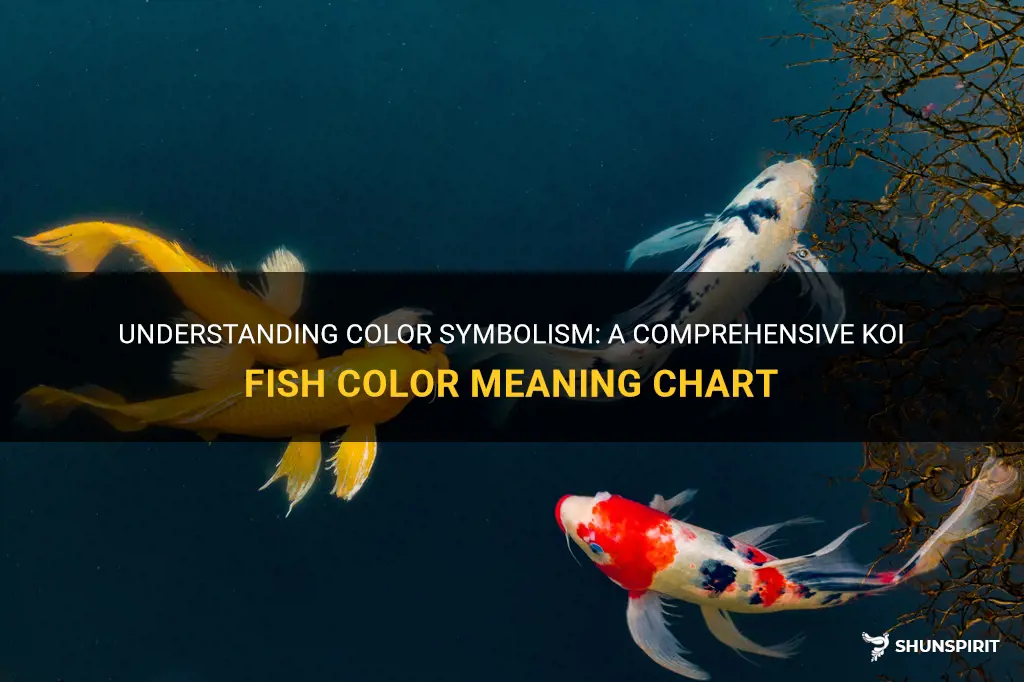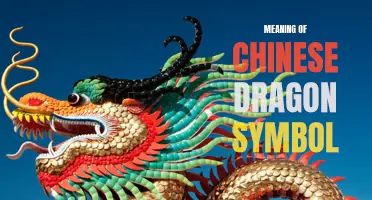
Color is a powerful tool for communication and symbolism, as different colors can evoke different emotions and convey various meanings. One fascinating example of this is found in the world of koi fish. These remarkable creatures are not only known for their beauty, but also for their diverse range of colors, each of which holds a unique symbolic significance. From the bold red of the Kohaku to the serene white of the Kumonryu, the koi fish color meaning chart is a captivating exploration of how color can illuminate the deeper qualities and traits that lie beneath the surface. Join me as we dive into this vibrant world and unravel the hidden meanings behind the colors of these magnificent fish.
What You'll Learn
- What are the different colors of koi fish and what do they symbolize?
- Is there a universal meaning for the colors of koi fish, or do different cultures interpret them differently?
- Are there any historical or cultural references that contribute to the symbolism of koi fish colors?
- How do the various colors of koi fish impact their value and popularity in the koi fish trade?
- Are there any myths or legends associated with specific colors of koi fish in different cultures?

What are the different colors of koi fish and what do they symbolize?
Koi fish are renowned for their stunning colors and patterns. Over the years, these ornamental fish have been selectively bred to showcase a wide variety of shades and hues, each with its own unique symbolism. In Japanese culture, koi fish symbolize good fortune, perseverance, and success. Let's take a closer look at some of the different colors of koi fish and what they symbolize.
- Kohaku: Similar to the Japanese flag, the kohaku koi features a vibrant red pattern on a white background. Red represents passion and energy, while white symbolizes purity. Kohaku koi are often associated with love and relationships.
- Yamabuki: This koi variety is known for its beautiful golden color, reminiscent of the yamabuki flower. Gold symbolizes wealth and prosperity in Japanese culture. Yamabuki koi are often seen as a representation of abundance and good luck.
- Showa: Showa koi are characterized by their black patterns on a white or dark blue base. The black color represents life's challenges and obstacles, while the white or blue background signifies purity and serenity. Showa koi are believed to bring strength and endurance.
- Ogon: Ogon koi are solid-colored, metallic fish that come in various shades, including gold, silver, and platinum. These koi symbolize success and wealth. The reflective metallic scales are associated with good fortune and abundance.
- Hajiro: The hajiro koi is predominantly white with small patches of black on its fins and body. This coloration represents perseverance and overcoming adversity. Hajiro koi are considered symbols of resilience and determination.
- Bekko: Bekko koi have a solid base color of either red, yellow, or white, with black markings on their bodies. The black patches are said to represent mystery and wisdom. Bekko koi are seen as symbols of enlightenment and inner strength.
- Matsuba: The matsuba koi has a single-colored base with a distinct reticulated net pattern of black scales. This pattern resembles the pine cones found on Japanese black pine trees. Matsuba koi are believed to bring good luck and protection from evil.
- Asagi: Asagi koi are known for their blue-gray or pale blue coloration on their upper bodies, along with their vibrant red or orange underbellies. The blue color represents tranquility and peace, while the red symbolizes energy and good health. Asagi koi are often associated with harmony and balance.
These are just a few examples of the vast array of colors and patterns found in koi fish. Each color carries its own significance and symbolism, adding to the allure and mystique of these beautiful creatures. Whether you own koi fish for their aesthetic appeal or for their symbolic meaning, they are sure to bring joy and positivity to any pond or garden.
Understanding the Symbol Meanings on Your Netgear Router
You may want to see also

Is there a universal meaning for the colors of koi fish, or do different cultures interpret them differently?
Koi fish are known for their vibrant colors and are often regarded as symbols of good luck and fortune. These beautiful creatures come in a variety of hues and patterns, making them incredibly popular among fish enthusiasts and collectors. But is there a universal meaning for the colors of koi fish, or do different cultures interpret them differently? Let's explore.
In many Asian cultures, koi fish, specifically those with red and white coloring, hold great significance. The color red symbolizes power, courage, and success, while white represents purity and a clean slate. When these two colors are combined, they create the perfect balance of yin and yang, representing harmony and balance in life.
In Japanese culture, koi fish are often associated with perseverance and determination. This stems from the story of the koi fish swimming upstream against strong currents to reach the Dragon's Gate, where it transforms into a dragon as a reward for its perseverance. Because of this tale, koi fish tattoos are popular in Japan and are seen as a symbol of strength and overcoming adversity.
In Chinese culture, koi fish are revered for their association with wealth and abundance. They are often depicted swimming upstream, symbolizing perseverance and the ability to overcome obstacles. The vibrant colors of koi fish are also believed to attract prosperity and good fortune.
However, it's important to note that not all cultures attribute the same meanings to koi fish colors. In Western cultures, for example, koi fish are admired primarily for their aesthetic appeal rather than their symbolic meaning. While some may appreciate the cultural significance behind the colors of koi fish, it is not as deeply ingrained in Western traditions as it is in Asian cultures.
It's also worth mentioning that the meanings associated with koi fish colors can vary within different regions and even among individuals. Some people may have personal interpretations or preferences for certain colors based on their own experiences or beliefs.
In conclusion, while there are some common interpretations of koi fish colors in Asian cultures, it is not a universal rule. Different cultures may ascribe different meanings to the colors of koi fish, and individual interpretations can also vary. Ultimately, the beauty and symbolism of koi fish colors lie in the eyes of the beholder.
Understanding Mitsubishi Mirage Dashboard Symbols and Their Meanings
You may want to see also

Are there any historical or cultural references that contribute to the symbolism of koi fish colors?
In Japanese culture, koi fish are highly revered and symbolic creatures. The meaning and symbolism of koi fish colors have deep historical and cultural references that contribute to their symbolism.
Koi fish are a species of carp that have been selectively bred by the Japanese for centuries to produce vibrant and diverse colors. Each color has its own unique symbolism, representing different qualities or characteristics.
The most common colors of koi fish are white, red, yellow, black, and blue. Each color has a specific meaning attached to it in Japanese culture.
White koi fish symbolize purity, innocence, and spirituality. They are associated with femininity and are often seen as a representation of the yin energy in Taoist philosophy.
Red koi fish are traditionally associated with love, perseverance, and strength. These fish are often referred to as the "love koi" and are believed to bring good luck in relationships and love matters.
Yellow koi fish are commonly associated with wealth, prosperity, and abundance. They symbolize success and good fortune in business and financial matters.
Black koi fish are seen as a symbol of overcoming obstacles and challenges. They represent the ability to persevere through adversity and emerge stronger on the other side.
Blue koi fish are rare and highly sought after. They symbolize tranquility, peace, and calmness. Blue koi fish are often associated with spiritual growth and meditation.
These color symbolism of koi fish can also be traced back to ancient Chinese culture. In Chinese philosophy, each color represents an element or a specific energy. For example, white is associated with metal, red with fire, yellow with earth, black with water, and blue with wood.
The symbolism of koi fish colors extends beyond their cultural and historical references. Many people today keep koi fish in their ponds or gardens for their aesthetic beauty and the sense of tranquility they bring. The vibrant colors of koi fish can add a touch of vibrancy and harmony to any space.
In conclusion, the symbolism of koi fish colors is deeply rooted in Japanese and Chinese culture. Each color carries its own unique meaning and symbolism, representing various qualities and characteristics. Whether it is white for purity, red for love, yellow for wealth, black for strength, or blue for tranquility, koi fish colors have a rich historical and cultural significance that adds to their allure and beauty.
The Hidden Meanings Behind Tupperware Symbols Revealed
You may want to see also

How do the various colors of koi fish impact their value and popularity in the koi fish trade?
Koi fish, renowned for their vibrant and diverse colors, are not only cherished for their beauty but also highly valued in the koi fish trade. The various colors of koi fish have a significant impact on their value and popularity among fish enthusiasts.
One of the most sought-after colors in the koi fish trade is the Kohaku variety, which features vibrant red markings on a white background. These fish are highly prized due to their energetic and eye-catching appearance. The deeper and more vibrant the red color and the more distinct the white markings, the higher the value of the Kohaku koi.
Another highly valuable color variation is the Sanke, which combines red, black, and white patterns. Typically, a prized Sanke koi will have a crisp white base with well-defined red and black markings. The balance and symmetry of the three colors greatly influence the price and desirability of the fish.
Similarly, the Showa variety, characterized by black, red, and white patterns, is highly regarded by koi enthusiasts. Showa koi with a jet black base, vibrant red patterns, and a clean white background are considered top-quality and command a high price in the market.
The popularity of metallic koi, such as the Ogon and Yamabuki Ogon, has also been on the rise. The Ogon koi, with its single metallic color, is highly valued for its simplicity and brilliant sheen. The Yamabuki Ogon, a golden variety, is equally popular due to its radiant and reflective appearance. The value of metallic koi is often determined by the quality, intensity, and uniformity of their metallic scales.
Beyond the traditional colors, the rising popularity of unique and rare color variations has added another dimension to the koi fish trade. These include colors such as purples, blues, and greens, which are achieved through selective breeding and manipulation of pigmentation.
While the color of a koi fish plays a pivotal role in determining its value and desirability, other factors such as body shape, pattern quality, and condition also contribute to its overall worth. The combination of desirable colors with these additional attributes elevates a koi's value even further.
In conclusion, the various colors of koi fish significantly impact their value and popularity in the koi fish trade. From vibrant reds and whites to metallic sheens and unique color variations, each hue has its own allure and market demand. As koi enthusiasts continue to appreciate the beauty and diversity of these magnificent fish, the demand for different colors will continue to shape the market and drive the value of these aquatic treasures.
What Does the Moon Symbol Mean on Discord: Exploring its Significance
You may want to see also

Are there any myths or legends associated with specific colors of koi fish in different cultures?
Koi fish are known for their vibrant colors and stunning beauty. In many cultures, these fish are associated with various myths and legends, often based on their colors. Let's explore some of these cultural beliefs and stories related to specific colors of koi fish.
In Japanese culture, koi fish hold a special place and are believed to possess mystical qualities. One of the most popular legends is the story of the dragon gate. According to this myth, if a koi fish successfully swims upstream and reaches the top of a waterfall called the dragon gate, it will transform into a dragon. The koi fish's determination and perseverance symbolize overcoming adversity and achieving success. In this legend, the koi fish represents strength and courage, regardless of its color.
In Chinese culture, each color of koi fish is associated with specific meanings. The red or orange koi symbolizes love, while the black koi represents overcoming obstacles and life's challenges. The blue koi fish is believed to bring tranquility and serenity, and the yellow koi represents wealth and prosperity. In Chinese mythology, there is a belief that if a koi fish is able to swim upstream the Yellow River and transform into a dragon, it will bring good luck and prosperity to its owner.
In Hindu mythology, the koi fish is associated with Lord Vishnu, one of the most significant gods in Hinduism. Lord Vishnu is often depicted resting on a thousand-headed snake, with a koi fish swimming alongside him. The koi fish is seen as a symbol of ambition and perseverance, and it is believed that those who possess these qualities will be blessed by Lord Vishnu.
In addition to these cultural beliefs, koi fish colors have also been associated with certain virtues and qualities. The white koi fish is believed to symbolize purity and innocence, while the gold or yellow koi is associated with wealth and prosperity. Black koi fish are often seen as a representation of masculinity and strength, while the red or orange koi is said to bring good luck and happiness.
It is important to note that these cultural beliefs and associations may vary from region to region and even within different communities. However, they all share the common theme of attributing certain qualities and meanings to the vibrant colors of koi fish.
In conclusion, koi fish have been the subject of many myths and legends across different cultures. These stories often center around the colors of the fish and associate them with specific virtues and qualities. Whether it's the perseverance and determination symbolized by the koi fish in Japanese culture or the prosperity and good luck associated with certain colors in Chinese mythology, these beliefs add to the allure and mystique of these beautiful creatures.
Decoding the Mystical Symbolism of the Kybalion
You may want to see also
Frequently asked questions
A red koi fish is often associated with love and romance. It is considered to be a symbol of strong and passionate emotions. In Japanese culture, red is also believed to bring good luck and good fortune.
A black koi fish is often associated with overcoming obstacles and adversity. It is seen as a symbol of strength and resilience. In Japanese culture, black is also associated with mystery and the unknown.
A white koi fish is often associated with purity and spiritual enlightenment. It is seen as a symbol of peace and tranquility. In Japanese culture, white is also associated with purity and innocence.
A yellow koi fish is often associated with wealth and prosperity. It is seen as a symbol of abundance and good fortune. In Japanese culture, yellow is also associated with happiness and joy.







